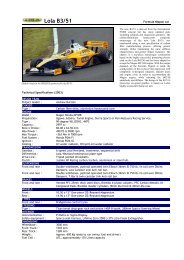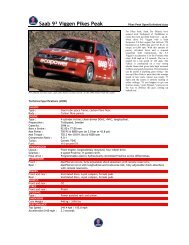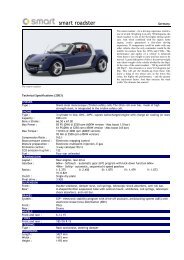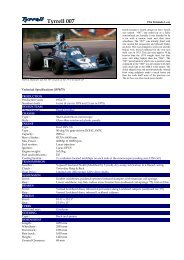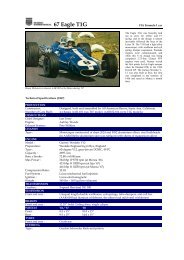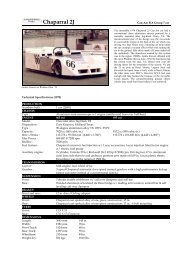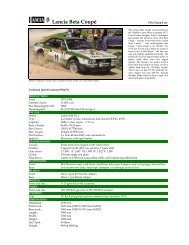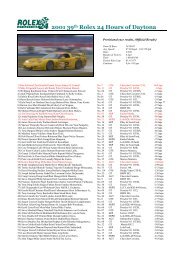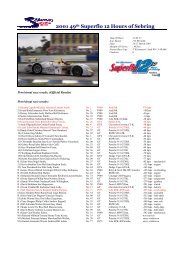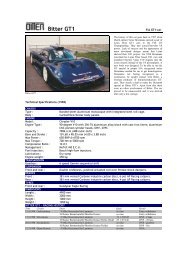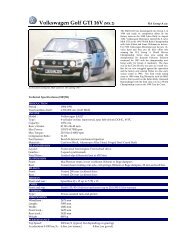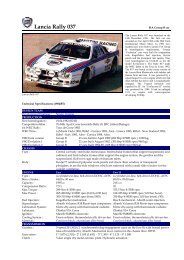84 Renault 5 Turbo - Motorsports Almanac
84 Renault 5 Turbo - Motorsports Almanac
84 Renault 5 Turbo - Motorsports Almanac
You also want an ePaper? Increase the reach of your titles
YUMPU automatically turns print PDFs into web optimized ePapers that Google loves.
Cooling System : Pressurised cooling system with aluminium radiator.<br />
Materials : Cast iron block, light alloy head.<br />
TRANSMISSION<br />
Layout : Rear wheel drive, mid-engine installed ahead of the rear axle. Tripod CVJs, ø 82<br />
mm driveshafts.<br />
Gearbox : 5-speed <strong>Renault</strong> 369 (derived from <strong>Renault</strong> 30 TX), all synchromesh, manual shift,<br />
aluminium alloy casing, with cooling via radiator and electric pump.<br />
Ratio : I : 3,364: 1 (37/11)<br />
II : 2,059: 1 (35/17)<br />
III : 1,381: 1 (29/21)<br />
IV : 1,057: 1 (37/35)<br />
V : 0,868: 1 (33/38)<br />
R : 3,182: 1 (35/11)<br />
Final drive : Ratio: 3,889: 1 (35/9) 9 x 35 8 x 35, 9 x 31<br />
Clutch : MFZ 190 single dry-plate<br />
SUSPENSION<br />
Front : Double wheel-locating wishbones - load supporting lower wishbone, longitudinal<br />
torsion bars. Shock-dampers, 21mm anti-roll bar.<br />
Rear : Double wheel-locating wishbones, coil-over-dampers , 23mm anti-roll bar<br />
BRAKES<br />
Front and rear : 260 mm vented discs, ø 54 mm DBA series IV single-pot calipers<br />
WHEELS<br />
Front : 135 x 340 mm (TRX type)<br />
Rear : 195 x 365 mm (TRX type)<br />
TYRES<br />
Front : 190/55HR340 Michelin TRX<br />
Rear : 220/55VR365 Michelin TRX<br />
STEERING<br />
Type : Rack-and-pinion, 330 mm steering wheel, 3.2 turns end-to-end.<br />
ELECTRICAL SYSTEM<br />
Battery : 12V 250/50 Ah.<br />
Alternator output: 50 A. Integral regulator.<br />
DIMENSIONS<br />
Length : 3.66m<br />
Width : 1.74m<br />
Height : 1.32<br />
Turning circle, kerbs : 10.40 m<br />
Turning circle, walls : 10.90 m<br />
Kerb weight : 930kg<br />
Fuel tank : 93 litres<br />
PERFORMANCE<br />
Top Speed: 170-250kph depending on gearing<br />
Acceleration: 0-400m : 15.0sec<br />
RENAULT 5 TURBO HISTORY<br />
In 1972 <strong>Renault</strong> adopted the turbocharged engine in motor sport, an invention patented 70 years earlier by its<br />
founder. After wins in the Le Mans 24 Hours, the Monte-Carlo Rally and numerous Formula 1 Grands Prix, the<br />
turbo was adapted for production models. On December 17, 1902 the French patents office registered an<br />
application for a patent lodged by Louis <strong>Renault</strong>. The invention in question was "intended to increase the<br />
intake pressure of gas into cylinders of internal combustion engines [to] increase [...] the quantity of gas<br />
admitted into the cylinder on each aspiration. This quantity of gas being greater, compression will be higher,<br />
the effect of combustion greater and there will therefore be an increase in engine power." To obtain this result,<br />
Louis <strong>Renault</strong> installed "a fan or a small compressor on the tube carrying the combustible gases to the engine",<br />
the intake manifold of which was linked to the carburettor. The principle of supercharging by<br />
turbocompression was born. It was used in aviation and on <strong>Renault</strong> railway diesels until the 1960s, before<br />
coming back again ten years later, this time in the car. In Formula 3, <strong>Renault</strong> Alpines fitted with the 1600 cc<br />
<strong>Renault</strong> 16 engine were racing against higher-capacity engines. The idea of turbocompression emerged as the<br />
only way of increasing power without increasing engine capacity: the compressor could be driven by energy<br />
from the exhaust gas as opposed to engine-generated mechanical energy. Difficult beginnings Although the<br />
principle was simple enough, installing a turbocharger on a petrol engine required high-performance materials<br />
that could withstand pressure and delicate adjustments to be performed that the F3 engineers had neither the<br />
time nor the means to carry out. A talented engine mechanic by the name of Bernard Dudot (now technical<br />
director of <strong>Renault</strong> Sport) "souped up" an Alpine Berlinette with a supercharger which increased its power by<br />
nearly 30% (giving it very nearly 200 bhp!), but still qualified it for the starting grid of the 1972 Civennes<br />
criterium. It pulled off a completely unexpected victory, due as much to the talent of its driver, Jean-Luc



